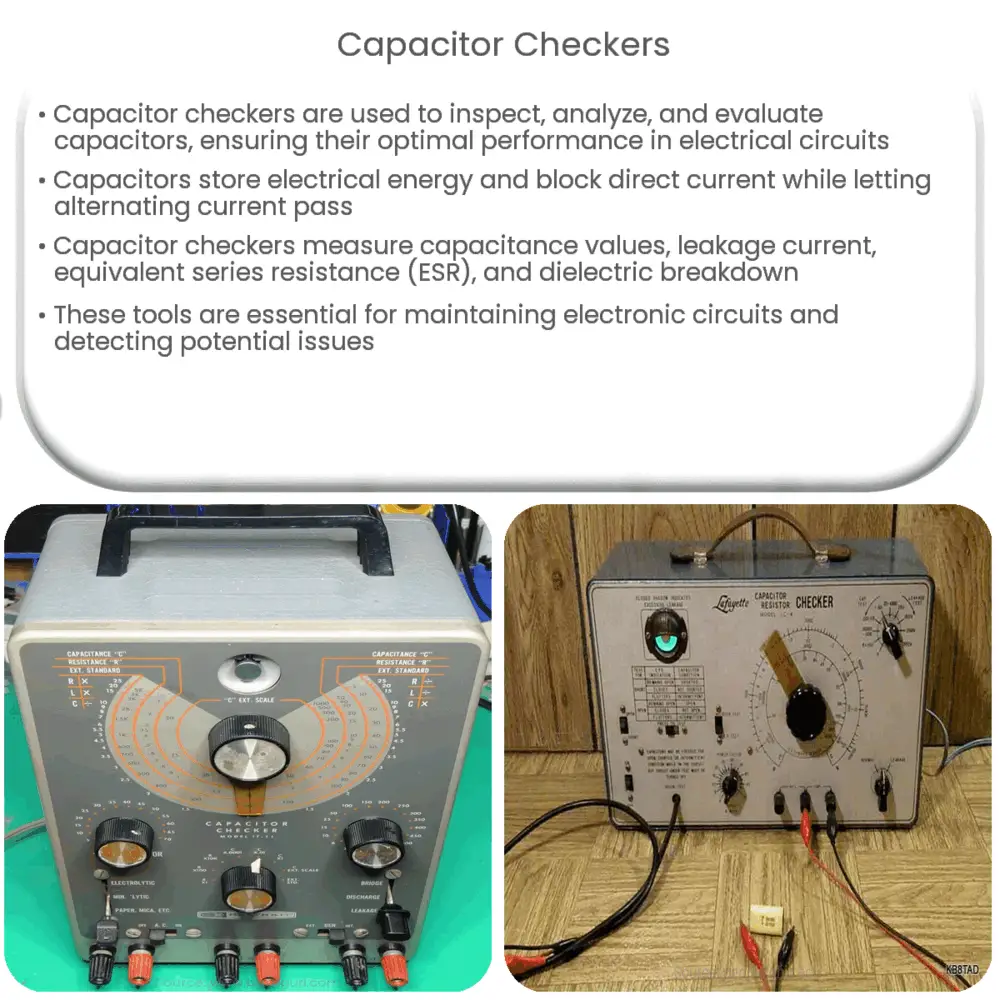Explore the role of Capacitor Checkers in electronic circuit health, their types, operation, and choosing the right one for your needs.

Introduction
The process of inspecting, analyzing, and evaluating capacitors is often referred to as ‘Capacitor Checkers.’ This essential practice aids in determining the performance and lifespan of these ubiquitous electrical components. Capacitor checkers are sophisticated devices or methods employed to verify the functionality of capacitors, which play crucial roles in various electrical and electronic circuits.
What is a Capacitor?
A capacitor is a two-terminal electronic component that stores electrical energy in an electric field. The effect of a capacitor is known as capacitance. They are widely utilized in electronic circuits for blocking direct current while allowing alternating current to pass. In this capacity, they are employed in filters, oscillators, and power supply circuits, among other things.
Importance of Capacitor Checkers
Given the vital role that capacitors play in electronics, it’s essential that these components are in good working order. This is where capacitor checkers come into play. Their primary function is to ensure that capacitors are operating correctly, and they do this by measuring the capacitance values, leakage current, equivalent series resistance (ESR), and dielectric breakdown, among other parameters.
- Capacitance Values: The core function of a capacitor checker is to measure the capacitance value, which should match the value specified by the manufacturer. If the value deviates significantly, it may signify a problem.
- Leakage Current: Capacitors should ideally block all direct current (DC), allowing only alternating current (AC) to pass through. However, in reality, a small amount of DC, known as leakage current, can pass. Capacitor checkers measure this to ensure it’s within an acceptable range.
- Equivalent Series Resistance (ESR): This value represents the internal resistance within the capacitor. A higher ESR may lead to inefficiencies and overheating. Hence, checking this value is crucial.
- Dielectric Breakdown: It refers to the failure of the dielectric material inside the capacitor, leading to a sudden surge of current. A capacitor checker can detect signs of an impending dielectric breakdown.
To maintain the optimal performance of electronic circuits and devices, a routine check using a reliable capacitor checker is advisable. As technology advances, these checkers are becoming more sophisticated and capable of quickly diagnosing potential issues.
Types of Capacitor Checkers
There are mainly two types of capacitor checkers:
- Analog Capacitor Checkers: These are traditional devices that use needle-based meters to display readings. Although less common in modern settings, they are appreciated for their durability and reliability.
- Digital Capacitor Checkers: These devices offer greater accuracy and ease of use. With digital displays and intuitive interfaces, they provide rapid and precise readings of the various capacitor parameters.
Working of a Capacitor Checker
The operation of a capacitor checker is fairly straightforward. The checker is connected across the terminals of the capacitor. Depending on the specific model of the checker, it will measure various parameters and display the results. The user can then compare these readings with the manufacturer’s specifications to determine if the capacitor is functioning correctly.
Choosing the Right Capacitor Checker
When selecting a capacitor checker, a few key considerations can guide the decision:
- Range of Capacitance: Different checkers have different capacitance ranges they can measure. Choose a model that suits the range of capacitors you’ll be working with.
- Additional Features: Some checkers also measure parameters such as ESR, leakage current, and dielectric breakdown. If these measurements are important in your work, consider a checker with these capabilities.
- Ease of Use: User-friendliness can greatly impact efficiency. Features such as digital displays and simple interfaces can make the checker easier to use.
Conclusion
Capacitor checkers are an essential tool in maintaining the health and functionality of electronic circuits. By allowing users to measure key parameters of capacitors, these devices enable the early detection of potential issues and ensure the longevity of electronic equipment. As technology continues to evolve, we can expect the development of even more sophisticated and precise capacitor checking tools. Thus, understanding and employing these devices is an invaluable skill in the field of electronics.

